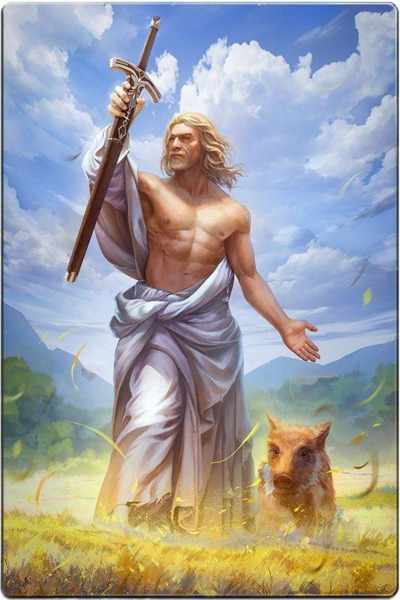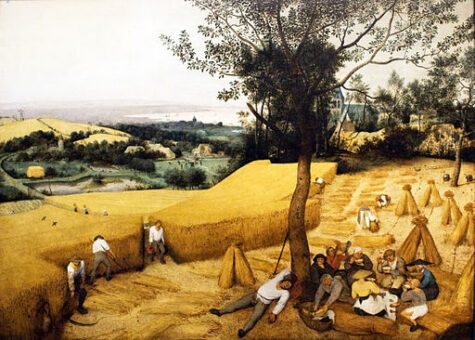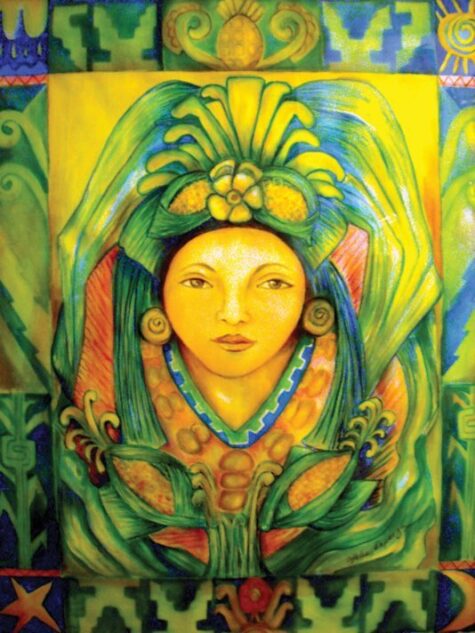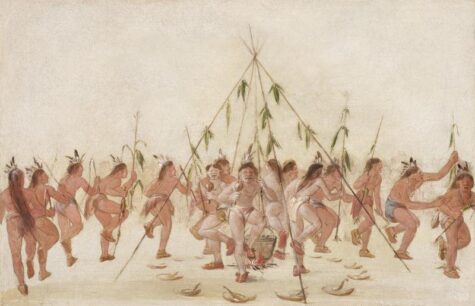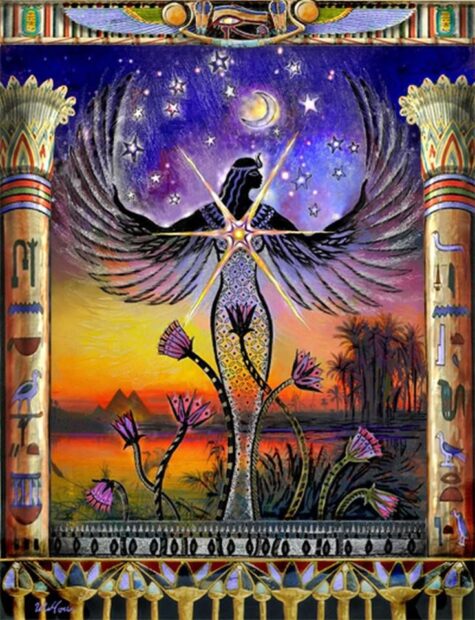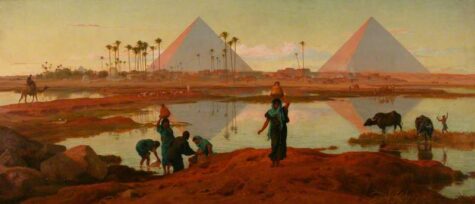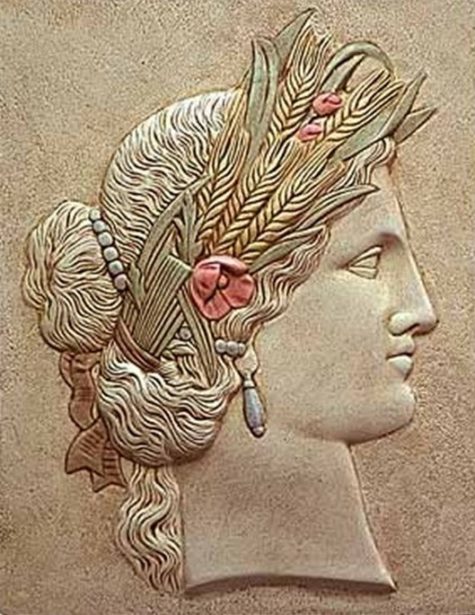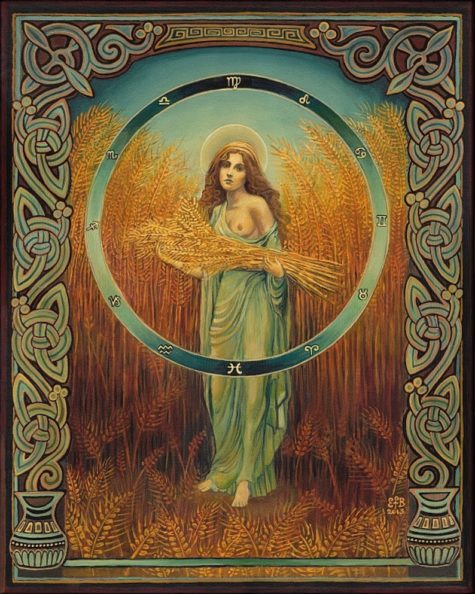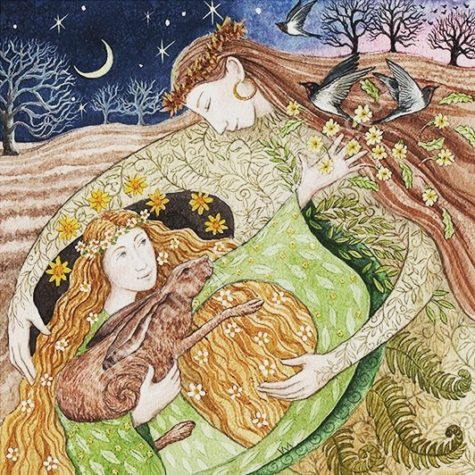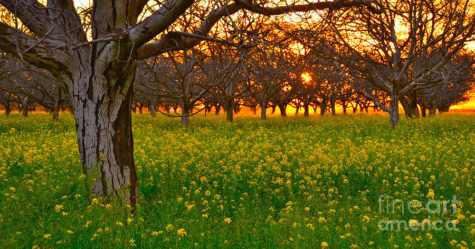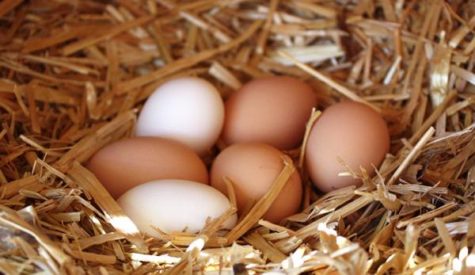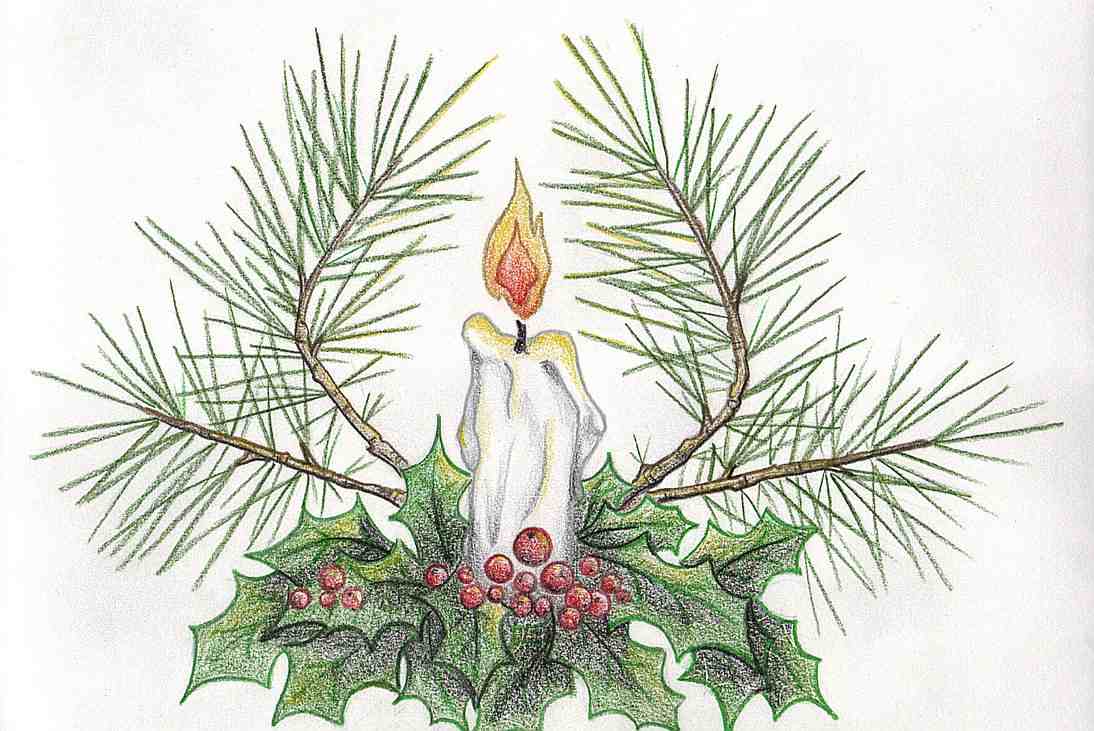Farming and Husbandry
Freyfaxi, Freysblöt, or Hlæfæst (which means Loaf Feast) which celebrates the beginning of the harvest. There is no specific “correct” date for this harvest festival; some groups celebrate it at the beginning of the month (to coincide with Lammas), some mid-month, and some on the full moon.
Freyr is the Norse god of fertility and harvest and a blöt is a sacrifice or offering to a god. So Freysblöt is offerings to Freyr, this is done in celebration of the beginning of harvest. The feast is also thought of as holy to Thor as a harvest God and his wife Sif, whose long golden hair can be seen in fields of ripe grain.
The first sheaf of harvested grain was bound and blessed for the gods and the vaettir (land or place spirits). Bread baked from the first harvest was also made into an offering and shared with the community.
In Viking times this is also when the warriors who had gone off to fight at the end of planting season came back, loaded with a summer’s worth of plunder and ready to reap the crops that had ripened while they were gone. It is almost like American thanksgiving, feasting and celebrating the first fruits and grains from harvest.
In modern times this is often just before back-to-school giving families and kindreds a good opportunity to celebrate together before the added stresses of homework and extracurricular activities. While the celebrations were modest compared to some of the other major holidays it was still an excellent reason to gather in celebration and to recognize the prosperity in our lives.
Since it draws from First Harvest traditions, the dates would vary regionally, but falls sometime in the beginning of August, because that is when many of our gardens are coming into full production. Typically in the northern hemisphere it is around this time that we celebrate the bounty of the Earth, and the gifts that she brings us with the help of Frey.
In truth, “Freyfaxi” is basically made up and can be celebrated by any group that wants to when they want to. It isn’t wholly without reference, as it draws on a history of First Harvest traditions, but it isn’t historical by any means. Wikipedia pins it on August 1st, the Ásatrú Alliance’s holidays page dates it as August 19th, and many Pagan Calendars date it to August 23rd.
Loaf-Feast is the end of the summer’s vacation, the beginning of a time of hard work which lasts through the next two or three months, while we ready ourselves for the winter.
The holiday of FreyFaxi was much more important for the lives of our ancestors that it is today. Without a good harvest, many many people would perish in the winter. We honor Frey to thank him for the many harvests that we have had, if there was one terrible one, some of us may not be here today. Thanks to Frey we are. If a year was particularly horrible, drastic sacrifice would be used – animal, or even human in some cases.
Even though many of us are no longer farmers, we still depend on the land for all that we are given. Maybe we do not depend on it directly but most of us go to the grocery store and buy things that have come from the fields. This is a time to honor Frey, god of the harvest, rains, and fertility. A time to thank him for the bounty of the earth, and all the gifts that he bestows upon us.
Today we honor him with mead, or some type of drink, food from our table, typically foods we harvest ourselves, for example baked bread that we have made ourselves from the wheat he has bestowed upon us. It is traditional to mark the holiday by baking a figure of the God Freyr in bread, and then symbolically sacrificing and eating it. Any way that you honor Frey, is a good way. Traditionally however, it is with a blot and feast.
We honor him because without him, simply we would not have much of our food supply, and quite obviously without that, we do not have much at all! He bestows fertility to the fields and plants, gives them life, giving rain so that they may grow and flourish. These plants including trees, give us oxygen. So if you are not going to honor Frey, son of Njord, for the bounty of the land at least honor him for the life of the plants and world around us!
We honor Frey by giving him a blot, and a grand feast from our own gardens and the fields. (If you do not have these things at least go spend some money and get a few things from a farmers market or something similar). We thank Frey, and honor him for the harvest and the fertility of the land and ask him to give the land even greater fertility in the coming year and in the dark of winter.
Sources:
The Green Corn Ceremony typically occurs in late July– early August, determined locally by the ripening of the corn crops. The ceremony is marked with dancing, feasting, fasting and religious observations.
The Green Corn Ceremony is a celebration of many types, representing new beginnings. Also referred to as the Great Peace Ceremony, it is a celebration of thanksgiving to Hsaketumese (The Breath Maker) for the first fruits of the harvest, and a New Year festival as well.
The Feast of Green Corn and Dance gives honor to Mantoo (Creator) provider of all things and celebrates our harvest, ancestors, elders, veterans, family and Native American heritage.
The Green Corn Ceremony is an annual ceremony practiced among various Native American peoples associated with the beginning of the yearly corn harvest.
These ceremonies have been documented ethnographically throughout the North American Eastern Woodlands and Southeastern tribes. Historically, it involved a first fruits rite in which the community would sacrifice the first of the green corn to ensure the rest of the crop would be successful.
These Green Corn festivals were practiced widely throughout southern North America by many tribes evidenced in the Mississippian people and throughout the Mississippian Ideological Interaction Sphere. Green Corn festivals are still held today by many different Southeastern Woodland tribes.
Literally the spirit of the corn in Native American traditions, Corn Mother brings with her the bounty of earth, its healing capabilities, it’s nurturing nature, and its providence.
- Symbols: Corn; Corn Sheaves
- Themes: Abundance; Children; Energy; Fertility; Harvest; Health; Grounding; Providence; Strength
This is the season when Corn Mother really shines, beautiful with the harvest. She is happy to share of this bounty and give all those who seek her an appreciation of self, a healthy dose of practicality, and a measure of good common sense.
To Do Today:
Around this time of year the Seminole Indians (in the Florida area) dance the green corn dance to welcome the crop and ensure ongoing fertility in the fields and tribe. This also marks the beginning of the Seminole year. So, if you enjoy dancing, grab a partner and dance? Or, perhaps do some dance aerobics. As you do, breathe deeply and release your stress into Corn Mother’s keeping. she will turn it into something positive, just as the land takes waste and makes it into beauty.
Using corn in rituals and spells is perfectly fitting for this occasion. Scatter cornmeal around the sacred space to mark your magic circle, or scatter it to the wind so Corn Mother can bring fertility back to you. Keeping a dried ear of corn in the house invokes Corn Mother’s protection and luck, consuming corn internalizes her blessings.
The traditional Ceremony:
The Busk or Green Corn Ceremony is the celebration of the New Year, so at this time all offenses are forgiven except for rape and murder, which are executable or banishable offenses.
In modern tribal towns and Stomp Dance societies only the ceremonial fire, the cook fires and certain other ceremonial objects will be replaced. Everyone usually begins gathering by the weekend prior to the ceremony, working, praying, dancing and fasting off and on until the big day.
The whole festival tends to last seven-eight days, if you include the historical preparation involved (without the preparation, it lasts about four days).
- Day One
The first day of the ceremony, people set up their campsites on one of the square ceremonial grounds. Following this, there is a feast of the remains of last year’s crop, after which all the men of the community begin fasting (historically, the women were considered too weak to participate). That night there is a social stomp dance, unique to the Muscogee and Southeastern cultures.
- Day Two
Before dawn on the second day, four brush-covered arbors are set up on the edges of the ceremonial grounds, one in each of the sacred directions.
For the first dance of the day, the women of the community participate in a Ribbon or Ladies Dance, which involves fastening rattles and shells to their legs perform a purifying dance with special ribbon-clad sticks to prepare the ceremonial ground for the renewal ceremony.
The ceremonial fire is set in the middle of four logs laid crosswise, so as to point to the four directions. The Mico (head priest) takes out a little of each of the new crops (not just corn, but beans, squash, wild plants, and others) rubbed with bear oil, and it is offered together with some meat as “first-fruits” and an atonement for all sins.
The fire (which has been re-lit and nurtured with a special medicine by the Mico) will be kept alive until the following year’s Green Corn Ceremony. In traditional times, the women would sweep out their cook-fires and the rest of their homes and collect the filth from this, as well as any old clothing and furniture to be burnt and replaced with new items for the new year.
The women then bring the coals of the fire into their homes, to rekindle their home fires. They can then bake the new fruits of the year over this fire (also to be eaten with bear oil). Many Creeks also practice the sapi or ceremonial scratches, a type of bloodletting in the mid morning, and in many tribes the men and women might rub corn milk, ash, white clay, or analogous mixtures over themselves and bathe as a form of purification.
They also drink a medicine referred to as the “White Drink.” (English traders referred to it as the “Black Drink” due to its dark liquid which froths white when shaken before drinking).
This White Drink, known to strangers as Carolina Tea, is a caffeine-laden mixture of seven to fourteen different herbs, the main ingredient being assi-luputski, Creek for “small leaves” of Yaupon Holly.
This medicine was intended to help receive purification, as it is a purgative when consumed in mass amounts. (Historically, only men drank enough of the liquid to throw up.) The purgative was consumed to clean the dietary tract of last year’s crop and to truly renew oneself for the new year.
- Day Three
While the second day tends to focus on the women’s dance, the third is focused on the men’s. After the purification of the second day, men of the community perform the Feather Dance to heal the community.
The fasting usually ends by supper-time after the word is given by the women that the food is prepared, at which time the men march in single-file formation down to a body of water, typically a flowing creek or river for a ceremonial dip in the water and private men’s meeting. They then return to the ceremonial square and perform a single Stomp Dance before retiring to their home camps for a feast.
During this time, the participants in the medicine rites are not allowed to sleep, as part of their fast. At midnight a Stomp Dance ceremony is held, which includes feasting and continues on through the night. This ceremony usually ends shortly after dawn.
- Day Four
The fourth day has friendship dances at dawn, games, and people later pack up and return home with their feelings of purification and forgiveness. Fasting from alcohol, sexual activity, and open water will continue for another four days.
More Information
Puskita, commonly referred to as the “Green Corn Ceremony” or “Busk,” is the central and most festive holiday of the traditional Muscogee people. It represents not only the renewal of the annual cycle, but of the spirit and traditions of the Muscogee. This is representative of the return of summer, the ripening of the new corn, and the common Native American traditions of environmental and agricultural renewal.
Historically in the Seminole tribe, 12-year-old boys are declared men at the Green Corn Ceremony, and given new names by the chief as a mark of their maturity.
Several tribes still participate in these ceremonies each year, but tribes who have historic tradition within the ceremony include the Iroquois, Cherokee, Creek, Choctaw, and Seminole tribes. Each of these tribes may have their own variations of celebration, dances and traditions, but each performs a new-year’s ceremony involving fasting and several other comparisons each year.
Sources:
July 19 was a very important date in ancient Egyptian Cosmology. Known as ‘The Opening of the Year,” or the “Sothic New Year,” it was celebrated with a festival known as “The Coming of Sopdet.”
The oldest festival in ancient Egyptian history, the celebration of The Opening of the New Year began with the rising of Sirius who appeared as the goddess Isis cloaked in robes of brilliant light.
The sky is serene. Sothis lives. She shines, a peaceful flame.
Unas lives eternal as the son of Sothis,
As the child of Isis, as a child of Light,
As Earth is child of the Cosmos.
Unas is pure. She is pure,
As are all the gods whoever lived since the beginning of time
In the worlds above and in the worlds below.
They have been born the Imperishable Stars
Living within the Meshetiu, which shall never die.
~Pyramid Text Utterance 302
Sirius forms a part of the constellation Canis Major, sometimes referred to as the Dog Star. Of all the stars in the sky throughout the year, Sirius shines the brightest. The Greeks called the star Sothis, meaning “The Soul of Isis”. The Egyptians called her Sept or Sopdet, referring to the concept of preparing for the future. The ancient feast day name Per Sopdet may be translated as T”he Coming Forth of the Goddess.”
On this day Sirius, the “Dog Star”, rose together with Sun and announced the annual flooding of Nile River. The lands were watered and a black layer of slime covered them, providing humidity and fertilizer for next year’s harvest: the nation would not suffer of hunger. Thus it was the first year of the mystical Egyptian year, symbolizing transmutation and fertility.
Note: The actual date of this event in ancient Egypt is different than the current date because the date slowly varies within the Gregorian calendar, owing to its omission of three leap years every four centuries. It presently occurs on 3 August.
Ancient Egyptian Rites and Festivities
When Sirius reappeared as the morning star, the altars at the Isis temples of Philae, Karnak, and Dendera opened early. The portals and sanctuaries were aligned so precisely with the heavenly bodies that the predawn starlight of Sirius was projected onto the cult statue of the goddess. Thus began a season of preparation for the coming agricultural year and a celebration of the flood and fecundity of earth.
New Year’s Day in every temple across the land began with the lighting of the wicks for the temple fires. The glowing lamplight symbolized the eternal life of the spirit world and the flame’s earthly burning became a mirrored image of the glittering light of Sothis in the sky.
The lifting of the fires was usually followed by an offering of bread and prayers glorifying the dead, enacted in the northern corner of the temple – the northern region being linked with the souls of the ancestors, the Imperishable Ones who were the circumpolar stars.
When the Opening of the year or Wept Renpet was celebrated, it was also a day to celebrate the traditional birthday of the king and later the Pharoah – no matter the true date of his birth. The New Year’s Feast was an important festival in the life of the Egyptian ruler. It involved his ritually hoeing the ground and breaking the dirt clods in preparation for the sowing that would follow the receding waters.
The water stands and fails not, and the Nile carries a high flood. The days are long, the nights have hours, and the months come aright. The Gods are content and happy of heart, and life is spent in laughter and wonder.
~Prayer from the Sallier Papyrus
The galleries inside the pyramids point to the heavenly position of Sirius on such a day. Sirius was both the most important star of ancient Egyptian astronomy, and one of the Decans. Decans are star groups into which the night sky was divided, with each group appearing for ten days annually. The first night that Sirius is seen, just before dawn (heliacal rising) was noticed every year during July, and the Egyptians used this to mark the start of the New Year.
In fact, the “Sothic Rising” only coincided with the solar year once every 1460 years. The Roman emperor Antoninus Pius had a commemorative coin made to mark their coincidence in AD 139. The Sothic Cycle (the periods between the rising of the star) have been used by archaeologists trying to construct a chronology of Ancient Egypt.
About Sopdet
Sirius was named Sothis by Egyptians and from archaic ages it symbolized eternity and fertility. As early as the 1st Dynasty, she was known as ‘the bringer of the new year and the Nile flood. Sopdet took on the aspects of a goddess of not only the star and of the inundation, but of the fertility that came to the land of Egypt with the flood. The flood and the rising of Sirius also marked the ancient Egyptian New Year, and so she also was thought of as a goddess of the New Year.
- Themes: Fertility, Destiny, Time
- Symbols: Stars and Dogs.
Not just a goddess of the waters of the inundation, Sopdet had another link with water – she was believed to cleanse the pharaoh in the afterlife. It is interesting to note that the embalming of the dead took seventy days – the same amount of time that Sirius was not seen in the sky, before it’s yearly rising. She was a goddess of fertility to both the living and the dead.
In the Pyramid Texts, she is the goddess who prepares yearly sustenance for the pharaoh, ‘in this her name of “Year”‘. She is also thought to be a guide in the afterlife for the pharaoh, letting him fly into the sky to join the gods, showing him ‘goodly roads’ in the Field of Reeds and helping him become one of the imperishable stars. She was thought to be living on the horizon, encircled by the Duat.
The reigning Egyptian Queen of the Constellations, Sopdet lives in Sirius, guiding the heavens and thereby human destiny. Sopdet is the foundation around which the Egyptian calendar system revolved, Her star’s appearance heralding the beginning of the fertile season. Some scholars believe that the Star card of the Tarot is fashioned after this Goddess and Her attributes.
The long, hot days of summer are known as the ‘Dog Days‘ because they coincide with the rising of the dog star, Sirius. In ancient Egypt this was a welcome time as the Nile rose, bringing enriching water to the land.
Activities for Today
Go outside tonight and see if you can find Sirius. When you spy it, whisper a wish to Sopdet suited to Her attributes and your needs. For example, if you need to be more timely or meet a deadline, she’s the perfect Goddess to keep things on track.
If you’re curious about your destiny, watch that region of the sky and see if any shooting stars appear. If so, this is a message from Sopdet. A star moving on your right side is a positive omen; better days are ahead. Those on the left indicate the need for caution, and those straight ahead mean things will continue on an even keel for now. Nonetheless, seeing any shooting star means Sopdet has received your wish.”
- Recall a new beginning
Recall a time in your life when you were starting anew, perhaps after a divorce or when moving into a new home. Perhaps your new life followed the birth of a child or a change in career. Investigate what had to die in your old life in order for the new life to emerge. How did that feel as you stood poised on the brink of change?
- Explore your creativity
Explore what it means to be creative. Think about the most creative times in your life. Where did you live? How different did life seem then from the way it seems now? How was your time structured? What were you thinking, desiring, telling yourself on a daily basis? Can you duplicate any of that in your life now?
- Ten Things
Make a list right now of ten things you want to manifest in the next six months. Be specific. Plant three seeds for each thing you want to manifest, then tend to them. Mark each seed with a popsicle stick to indicate what goal you are germinating, so that when you water the plant, you stay focused on what you are nurturing within yourself.
Write a brief prayer to one of the abundance goddesses – Isis, Hathor, or Anket – asking her to guide you and oversee your fecundity. Say your prayer each time you tend your plants.
Sources:
- Tour Egypt
- Journeying To The Goddess
- Feasts of Light
Today (April 12) is the first day of the Ludi Cereales, another spring vegetation festival, this one in honor of the goddess Ceres, goddess of grains and cereal crops. It lasts for eight days, and like the Megalesia before it, the Cerealia culminates on its final day.
During Roman times, one of the symbolic rituals of the final day was the release of foxes into the Circus with flaming brands attached to their tails despite the fact that Ceres is notoriously a peaceful goddess and most often accepts offerings of spelt cakes and salt, as well as incense.
In the countryside, people offer milk, honey, and wine on the Cerealia (particularly the final day), after bearing them thrice around the fields.
More About This Festival
Ceres is the Goddess of agriculture, and was credited with the discovery of spelt wheat, the yoking of oxen and ploughing, the sowing, protection and nourishing of the young seed, and the gift of agriculture to humankind; before this, it was said, man had subsisted on acorns, and wandered without settlement or laws. She was the first to “break open the earth”, and all activities of the agricultural cycle were protected by her laws. She held the power to fertilize, multiply and fructify plant and animal seed, whose offspring were the physical incarnations of her power.
Her first plough-furrow opened the earth (Tellus’ realm) to the world of men and created the first field and its boundary; she thus determined the course of settled, lawful, civilized life. She mediated between plebeian and patrician factions. She oversaw the transition of women from girlhood to womanhood, from unmarried to married life and motherhood and the growth of children from infancy. Despite her chthonic connections to Tellus, she was not, according to Spaeth, an underworld deity. Rather, she maintained the boundaries between the realms of the living and the dead.
Given the appropriate rites, she would help the deceased into afterlife as an underworld shade (Di Manes): otherwise, the spirit of the deceased might remain among the living as a wandering, vengeful ghost.
The goddess was worshiped in many ways. There was the porca praecidanea, which involved sacrificing a fertile female pig and was necessary before a harvest. Cato indicates that sacrifices of any large food item will do, however, and suggests a pumpkin as an acceptable substitute for a pig, since it can be cut open and the seeds offered to Ceres in much the same way the entrails of the pig would be. After the offering of the porca praecidanea, it was customary to also give the goddess a libation of wine.
The poor could offer wheat, flowers, and a libation. The expectations of afterlife for initiates in the sacra Cereris may have been somewhat different, as they were offered “a method of living” and of “dying with better hope”.
Ceres’ major festival was the Cerealia – the ludi cereales, culminating on April 19 to celebrate the growth of grain and other agricultural products. Its original form is unknown; it may have been founded during the regal era. During the Republican era, it was organised by the plebeian aediles, and included ludi circenses (circus games). These opened with a horse race in the Circus Maximus, whose starting point lay just below the Aventine Temple of Ceres, Liber and Libera. In a nighttime ritual after the race, blazing torches were tied to the tails of live foxes, who were released into the Circus. The origin and purpose of this ritual are unknown; it may have been intended to cleanse the growing crops and protect them from disease and vermin, or to add warmth and vitality to their growth
Religiously, the purpose of the races and the games were to make the goddess favorably disposed toward the Roman people, so that she would give them a good harvest.
Visual depictions of Ceres were largely derived from Greek portrayals of Demeter. On two coin types, a bust of Ceres was pictured on one side, while a yoke of oxen was on the other. On other coins, she wears a crown of grain stalks called a corona spicea, holds stalks of wheat, and is occasionally pictured with wheat and barley grains. One coin actually portrayed her wearing a modius, an instrument used to measure grain, on her head. Another pictures a bust of series on one side, and a pair of seated male figures with a wheat stalk to their side on the other. The seated men represent the official distribution of grain to the people. Annona, the goddess who personified the wheat supply, appears alongside Ceres on several coins from the imperial period. Reliefs from the Augustan period have even gone so far as to depict her as a plant growing out of the ground. In one her bust emerges from the earth, holding bunches of poppies and grain in her upraised hands while two snakes twine about her arms.
Ceres also assimilated the visual symbols of the Eleusinian Mysteries, which most Romans observed in her name. Ceres is depicted with symbols of the Mysteries, such as riding in a chariot drawn by snakes while holding a torch in her right hand.
Persephone’s Return ~ A Ritual For The Cerelea
Most often celebrated on the last day of the Ludi Cereales (or April 19).
- Color: Green
- Element: Earth
- Offering: Flowers. Begin something new.
- Daily Meal: Dark, coarse bread. Root vegetables. Poppy seeds. Millet. Nuts and seeds.
Altar: Upon a green cloth set as many spring flowers as possible, a bowl of earth saved from the day of Persephone’s descent, and the figure of a girl’s head emerging from the earth.
Invocation to Persephone’s Return
Let the Earth take joy!
Demeter’s heart is warmed,
For her beloved daughter,
The maiden of Spring,
Has returned to the upper world!
Let all upon the Earth take joy!
Flowers spring from her footsteps,
Grass spreads between her toes,
The promise of the summer wind
Falls like butterflies newly loosed
From her hair the color of poppies and clay.
Let us all take joy!
She who descended in the autumn,
She who is married to Death
And yet arises in the bringing of Life,
She who has passed the bodies
Of a thousand corpses,
She who has sung with the shades
Of a thousand ancestors,
She rises to greet the morning sun
For as long as it is her time.
Then, like all things, she will descend again,
Into the depths of the Earth,
And we, we shall learn to love that cycle
Of rising and falling, of birth and death,
And truly call it a blessing.
Chant:
Kore Kore Kore Proserpina
Let one chosen for the work of the daily ritual carry the bowl of earth from person to person about the hall, and let each one take a bit of the earth and rub it on their faces, and let it remain until the evening ablutions.
~Info collected from various sources, including the Pagan Book of Hours
Tu Bishvat occurs on the 15th day of the Hebrew month of Shevat. In 2019, this date falls on January 20. Tu Bishvat (Tu B’Shevat), also called “Rosh HaShanah La’Ilanot” (New Year of the Trees) is kind of like a birthday for all trees. Trees planted before this day, even by one day, will turn a year older on Tu Bishvat. Traditionally fruit from trees may not be eaten for the first four years, so the age is important.
Here are some simple ways to celebrate The New Year of the Trees
- Pick fresh fruits and vegetables at a local farm.
- Plant trees, seeds, or start an herb garden.
- Build a birdhouse to hang in a tree.
- Eat the seven significant species of the land of Israel: wheat, grapes, barley, figs, pomegranates, olives, and dates.
- Organize a park clean-up to collect litter.
- Make something for your home with reclaimed wood.
- Take some time to research your own ancestry and assemble your family tree.
- Commit to recycling paper goods. If you don’t already have one, get a separate bin and you’re all set!
- Host a Tu B’Shevat Seder.
In the 16th century, the kabbalist Rabbi Yitzchak Luria of Safed developed a Tu Bishvat seder. The fruits and trees of Israel were given symbolic meaning. Eating ten specific fruits and drinking four cups of wine in a specific order while reciting blessings would bring people and the world closer to spiritual perfection.
How to Lead a Tu Bishvat Seder
Set up your table as for Passover: white or other nice tablecloth, good dishes, flowers, wine, and juice. There is no requirement to light candles, but scented candles add a nice touch and a festive glow. Either one person can lead the seder, reciting each reading and making the blessings, or everyone can take turns.
The directions concerning which fruit to locate and the mix of the wines should be read aloud. As each piece of fruit and each cup of wine is being considered and blessed, that object is held by the reader. After each blessing, the participants taste the fruit or sip the wine.
Hand Washing
Fill a large bowl with flower-scented water and float a small cup in it. Carry the bowl from person to person or set up a washing station in a corner. Feel how nice it is to place your hands over the bowl and have someone pour warm water over your fingers. Have towels ready.
Say this blessing
Barukh ata Adonai,
Eloheinu Melekh ha-olam,
asher kidshanu b’mitzvotav,
v’tzivanu al netilat yadayim.
Blessed are You,
Source of all life,
Who commands us to ritually wash our hands.
Note: Some may choose to forego this blessing, since it is traditionally recited upon washing the hands before eating bread, which is not eaten here.
First reading
Reader: And God said: Let the earth put forth grass, herb-yielding seed, and fruit-tree-bearing fruit after its own kind, wherein is the seed thereof, on the earth. (Genesis 1:11)
Reader: In the 16th century in northern Israel, in the spiritual town of Tzfat (Safed), the Jewish mystics created the Tu Bishvat seder. They recognized the many and varied dimensions of God’s creation and used the fruits of Israel to symbolize their existence.
The First Cup of Wine
This cup of white wine or grape juice symbolizes winter and the mystical dimension of atzilut, or emanation, at which God’s energy infused the creation process with initial life.
Barukh ata Adonai,
Eloheinu Melekh ha-olam borei peri ha-gafen.
Blessed are you,
Source of all life,
Creator of the fruit of the vine.
Reader: For Adonai your God is bringing you into a good land. A land of brooks of water, of fountains and depths springing forth in valleys and hills, a land of wheat and barley and vines and fig trees and pomegranates, a land of olive trees and honey, a land wherein you shall eat without scarceness, you shall not lack anything in it; a land whose stones are iron and out of whose hills you may dig brass. And you shall eat and be satisfied, and bless God for the good land, which is being given unto you (Deuteronomy 8:7-10).
The First Fruit
Fruit that is hard on the outside and soft on the inside, such as walnuts, coconuts or almonds. The hard shell symbolizes the protection that the earth gives us and reminds us to nourish the strength and healing power of our own bodies.
Barukh ata Adonai,
Eloheinu Melekh ha-olam,
borei peri ha-etz.
Blessed are You,
Source of all life,
Creator of the fruit of the tree.
The Second Cup of Wine
This cup of wine or grape juice is mostly white, with a little red mixed in, to symbolize the passing of the seasons and the mystical concept of formation and birth, often associated with water.
Barukh ata Adonai,
Eloheinu Melekh ha-olam,
borei peri ha-gafen.
Blessed are You,
Source of all life,
Creator of the fruit of the vine.
Reader: Blessed shall you be in the city, and blessed shall you be in the field. Blessed shall you be in the fruit of your body, and the fruit of your land, and the fruit of your cattle, and the young of your flock. Blessed shall you be in your basket and your kneading trough. Blessed shall you be when you come in and blessed shall you be when you go out (Deuteronomy 28:36).
The Second Fruit
This fruit is soft with a pit in the center — olives or dates [or peaches, apricots, etc.] — and symbolizes the life-sustaining power that emanates from the earth. It reminds us of the spiritual and emotional strength that is within each of us.
Barukh ata Adonai,
Eloheinu Melekh ha-olam,
borei peri ha-etz.
Blessed are You,
Source of all life,
Creator of the fruit of the tree.
The Third Cup of Wine
This cup of wine is mostly red with a little of white mixed in and symbolizes once again the change of seasons and the mystical concept of beriah, or creation.
Barukh ata Adonai,
Eloheinu Melekh ha-olam,
borei peri ha-gafen.
Blessed are You,
Source of all life,
Creator of the fruit of the vine.
Reader: Then God formed the human from the dust of the ground, and breathed into the nostrils the breath of life; and the human became a living soul (Genesis 2:7).
The Third Fruit
This fruit is soft throughout and is completely edible, such as figs, grapes, and raisins. This type symbolizes God’s omnipresence and our own inextricable ties with the earth.
Barukh ata Adonai,
Eloheinu Melekh ha-olam,
borei peri ha-etz.
Blessed are You,
Source of all life,
Creator of the fruit of the tree.
Serve a Vegetarian Dinner
A favorite is vegetarian lasagna and noodle kugel with fruit. Eat other exotic fruits that are placed around the table.
The Fourth Cup of Wine
This cup is all red, symbolizing the mystical concept of fire and the idea that within all living things dwells a spark of God.
Reader: And the angel of God appeared to him in a flame of fire out of the midst of a bush; and Moses looked, and behold, the bush burned with fire and the bush was not consumed (Exodus 3:2).
The Fourth Fruit
This has a tough skin on the outside but sweet fruit within–mangos, bananas, avocados, or sabra, a desert pear–and symbolizes the mystery of the world and our study of Torah. We are constantly seeking to uncover her secrets, and are continually nourished by her fruits.
Sources:
The best days listed here are based on both the phase of the moon and its position in the zodiac. Many people believe that if you do the tasks on the dates listed, you will get the best results possible.
January
- Cut Firewood: 5 – 20
- Dig Holes: 5 – 20
- Dig Post Holes: 21
- Mow To Increase Growth: 5 – 20
- Mow To Slow Growth: 1, 4, 21 – 31
February
- Cut Firewood: 4 – 18
- Dig Holes: 4 – 18
- Dig Post Holes: 3
- Mow To Increase Growth: 4 – 18
- Mow To Slow Growth: 1 – 3, 19 – 28
March
- Cut Firewood: 6 – 19
- Dig Holes: 6 – 19
- Dig Post Holes: 2 – 4, 29
- Mow To Increase Growth: 6 – 19
- Mow To Slow Growth: 1 – 5, 20 – 31
April
- Cut Firewood: 5 – 18
- Dig Holes: 5 – 18
- Dig Post Holes: 26, 27
- Mow To Increase Growth: 5 – 18
- Mow To Slow Growth: 1 – 4, 19 – 30
May
- Cut Firewood: 4 – 17
- Dig Holes: 4 – 17
- Dig Post Holes: 3, 23 – 25, 31
- Mow To Increase Growth: 4 – 17
- Mow To Slow Growth: 1 – 3, 18 – 31
June
- Cut Firewood: 3 – 16
- Dig Holes: 3 – 16
- Dig Post Holes: 1, 19 – 21, 27, 28
- Mow To Increase Growth: 3 – 16
- Mow To Slow Growth: 1, 2, 17 – 30
July
- Cut Firewood: 2 – 15, 31
- Dig Holes: 2 – 15, 31
- Dig Post Holes: 17, 18, 24 – 26
- Mow To Increase Growth: 2 – 15, 3
- Mow To Slow Growth: 1, 16 – 30
August
- Cut Firewood: 1– 14, 30, 31
- Dig Holes: 1– 14, 30, 31
- Dig Post Holes: 21, 22, 27, 28
- Mow To Increase Growth: 1– 14, 30, 31
- Mow To Slow Growth: 15– 29
September
- Cut Firewood: 1– 13, 28 – 30
- Dig Holes: 1– 13, 28 – 30
- Dig Post Holes: 14, 15, 21, 22
- Mow To Increase Growth: 1– 13, 28 – 30
- Mow To Slow Growth: 14 – 27
October
- Cut Firewood: 1 – 12, 27 – 31
- Dig Holes: 1 – 12, 27 – 31
- Dig Post Holes: 14, 15, 21, 22
- Mow To Increase Growth: 1 – 12, 27 – 31
- Mow To Slow Growth: 13 – 26
November
- Cut Firewood: 1 – 11, 26 – 30
- Dig Holes: 1 – 11, 26 – 30
- Dig Post Holes: 12, 17, 18
- Mow To Increase Growth: 1 – 11, 26 – 30
- Mow To Slow Growth: 12 – 25
December
- Cut Firewood: 1 – 11, 26 – 31
- Dig Holes: 1 – 11, 26 – 31
- Dig Post Holes: 14 – 16
- Mow To Increase Growth: 1 – 11, 26 – 31
- Mow To Slow Growth: 12 – 25
Source: The Farmer’s Almanac
Moon phase gardening is an idea as old as agriculture, popular in folklore and superstition. Planting by the phases of the moon maintains a rhythm with the alternating gravitational pull of the moon. (Read more at Gardening By The Moon). The best days for gardening by the moon in 2019 are as follows:
January
- Plant above ground crops: 5, 6, 9 – 11, 14, 15, 18, 19
- Plant root crops: 1, 4, 24 – 28, 31
- Transplant: 1, 27, 28
- Plant seed beds: 1, 18, 19, 27, 28
- Plant flowers: 18, 19, 24 – 26
- Kill plant pests: 2, 3, 7, 8, 12, 13, 16, 17, 20 – 23, 29, 30
- Harvest: 2, 3, 29, 30
- Pick Apples and Pears: 2, 3, 21, 29, 30
- Prune Trees: 1, 4, 27, 28, 31
February
- Plant above ground crops: 5 – 7, 10 – 12, 15, 16
- Plant root crops: 1, 2, 21 – 24, 28
- Transplant: 23, 24
- Plant seed beds: 15, 16, 23, 24
- Plant flowers: 15, 16, 21, 22
- Kill plant pests: 3, 4, 8, 9, 13, 14, 17 – 20, 25 – 27
- Harvest: 3, 26, 27
- Pick Apples and Pears: 25 – 27
- Prune Trees: 1, 2, 23, 24, 28
March
- Plant above ground crops: 6, 10, 11, 14, 15
- Plant root crops: 1, 5, 20 – 24, 27, 28
- Transplant: 5, 22 – 24
- Plant seed beds: 14, 15, 22 – 24
- Plant flowers: 14, 15, 20, 21
- Kill plant pests: 2 – 4, 7 – 9, 12, 13, 16 – 19, 25, 26, 29 – 31
- Harvest: 2 – 4, 29 – 31
- Pick Apples and Pears: 25 – 26
- Prune Trees: 1, 22 – 24, 27, 28
April
- Plant above ground crops: 6, 7, 10 – 12, 17, 18
- Plant root crops: 1, 2, 19, 20, 23 – 25, 28 – 30
- Transplant: 1, 2, 19, 20, 28 – 30
- Plant seed beds: 10 – 12, 19, 20
- Plant flowers: 10 – 12, 17, 18
- Kill plant pests: 3 – 5, 8, 9, 13 – 16, 21, 22, 26, 27
- Harvest: 3, 4, 26, 27
- Pick Apples and Pears: 3, 4, 21, 22
- Prune Trees: 19, 20, 23 – 25
May
- Plant above ground crops: 4, 8, 9, 14 – 17
- Plant root crops: 3, 21, 22, 26, 27, 31
- Transplant: 3, 26, 27, 31
- Plant seed beds: 8, 9, 16, 17
- Plant flowers: 8, 9, 14, 15
- Kill plant pests: 1, 2, 5 – 7, 10 – 13, 18 – 20, 23 – 25, 28 – 30
- Harvest: 1, 2, 28 – 30
- Pick Apples and Pears: 1, 2, 18 – 20, 28 – 30
- Prune Trees: 21, 22
June
- Plant above ground crops: 4, 5, 10 – 14
- Plant root crops: 1, 17, 18, 22, 23, 27, 28
- Transplant: 1, 22, 23, 27, 28
- Plant seed beds: 4, 5, 13, 14
- Plant flowers: 4, 5, 10 – 12
- Kill plant pests: 2, 3, 6 – 9, 15, 16, 19 – 21, 24 – 26, 29, 30
- Harvest: 2, 25, 26, 29, 30
- Pick Apples and Pears: 24 – 26
- Prune Trees: 17, 18
July
- Plant above ground crops: 2, 8 – 11, 14, 15
- Plant root crops: 1, 16, 19 – 21, 24 – 26, 29
- Transplant: 1, 19 – 21, 24 – 26, 29, 30
- Plant seed beds: 1, 2, 10, 11, 29, 30
- Plant flowers: 1, 2, 10, 11, 29, 30
- Kill plant pests: 3 – 7, 12, 13, 17, 18, 22, 23, 27, 28, 31
- Harvest: 27, 28
- Pick Apples and Pears: 22, 23
- Prune Trees: 16
August
- Plant above ground crops: 4 – 7, 11, 12, 31
- Plant root crops: 30
- Transplant: 15 – 17, 21, 22, 25, 26
- Plant seed beds: 6, 7, 25, 26
- Plant flowers: 4, 5, 25, 26, 31
- Kill plant pests: 1 – 3, 8 – 10, 13, 14, 18 – 20, 23, 24, 27 – 30
- Harvest: 23, 24, 27 – 29
- Pick Apples and Pears: 18 – 20, 27, 28
- Prune Trees: No good days
September
- Plant above ground crops: 1 – 3, 7, 8, 12, 13, 28 – 30
- Plant root crops: 15 – 17, 21, 22, 25, 26
- Transplant: 17, 18, 22, 23
- Plant seed beds: 2, 3, 22, 23, 30
- Plant flowers: 1, 22, 23, 28, 29
- Kill plant pests: 4 – 6, 9 – 11, 14 – 16, 19 – 21, 24 – 27
- Harvest: 21, 24 – 27
- Pick Apples and Pears: 14 – 16, 24, 25
- Prune Trees: No good days
October
- Plant above ground crops: 1, 4, 5, 9 – 11, 27, 28, 31
- Plant root crops: 17, 18, 22, 23
- Transplant: 14, 15, 19, 20
- Plant seed beds: 1, 19, 20, 27, 28
- Plant flowers: 19, 20, 25, 26
- Kill plant pests: 2, 3, 6 – 8, 12, 13, 16 – 18, 21 – 24, 29, 30
- Harvest: 21 – 24
- Pick Apples and Pears: 13, 21, 22
- Prune Trees: No good days
November
- Plant above ground crops: 1, 2, 5 – 7, 10, 11, 28, 29
- Plant root crops: 14, 15, 19, 20, 25, 26
- Transplant: 12, 15, 16, 24, 25
- Plant seed beds: 15, 16, 24, 25
- Plant flowers: 15, 16, 21 – 23
- Kill plant pests: 3, 4, 8, 9, 13, 14, 17 – 20, 26, 27, 30
- Harvest: 19, 20
- Pick Apples and Pears: 17, 18
- Prune Trees: 24, 25
December
- Plant above ground crops: 3, 4, 8, 9, 26, 27, 30, 31
- Plant root crops: 12, 15, 16, 21 – 25
- Transplant: 12,13, 21, 22
- Plant seed beds: 12,13, 21, 22
- Plant flowers: 12,13, 19, 22
- Kill plant pests: 1, 2, 5 – 7, 10, 11, 14 – 18, 23, 24, 28, 29
- Harvest: 18, 23, 24
- Pick Apples and Pears: 14 – 16, 23, 24
- Prune Trees: 21, 22, 25
Source: Farmer’s Almanac
Moon phase gardening is an idea as old as agriculture, popular in folklore and superstition, but there are scientific ideas to back it up.
The Earth is in a large gravitational field, influenced by both the sun and moon. The tides are highest at the time of the new and the full moon, when sun and moon are lined up with earth. Just as the moon pulls the tides in the oceans, it also pulls upon the subtle bodies of water, causing moisture to rise in the earth, which encourages growth.
The highest amount of moisture is in the soil at this time, and tests have proven that seeds will absorb the most water at the time of the full moon. Planting by the phases of the moon will keep in rhythm with the alternating gravitational pull.
Moon phase gardening considers four phases or quarters lasting about seven days each. The first two quarters are during the waxing or increasing light, from the new moon and growing up to the full moon.
New Moon
At the new moon, the lunar gravity pulls water up, and causes the seeds to swell and burst. This factor, coupled with the increasing moonlight creates balanced root and leaf growth.
The first quarter is the best time for planting above ground bearing annual crops that produce their seeds outside the fruit. Examples are lettuce, spinach, celery, broccoli, cabbage, cauliflower, and grain crops.
2nd Quarter Moon
In the second quarter the gravitational pull is less, but the moonlight is strong, creating healthy leaf growth. It is generally a good time for planting, especially two days before the full moon.
The types of crops that prefer the second quarter are annuals that produce above ground, but their seeds form inside the fruit, such as beans, melons, peas, peppers, squash, and tomatoes.
Plant just before the full moon to get the benefits of peak moisture.
Full Moon
The third and fourth quarters are after the full moon when the light is waning or decreasing, and the energy is drawing down.
The gravitation pull is high, creating more moisture in the soil, but the moonlight is decreasing, putting energy into the roots. This is a favorable time for planting root time for crops, such as beets and carrots.
It is also good for perennials, bulbs and transplanting because of the active root growth. Prune in Scorpio.
4th Quarter Moon
In the fourth quarter there is decreased gravitational pull and moonlight, and this is considered a resting period.
This is also the best time to cultivate, harvest, transplant, fertilize and prune. Mow lawns in the third or fourth quarter to retard growth. Use the water signs for deep watering of shrubs and trees.
Source: Gardening By The Moon
According to moon lore, for best results you should set eggs (place eggs under a hen or in an incubator) during specific phases of the moon. It occured to me that if these are good days to set eggs, they might also be good days for fertility magick.
Here are the optimum dates for 2019:
- January: 16 – 18, 26, 27
- February: 13, 14, 22, 23
- March: 21 – 23
- April: 18, 19, 26
- May: 15, 16, 24, 25
- June: 11, 12, 20, 21
- July: 10, 17, 18
- August: 13, 14, 23
- September: 10, 11, 19 – 21
- October: 7, 8, 16 – 18
- November: 5, 13, 14
- December: 10, 11
Source: The Farmers’ Almanac
Belenus, whose name means “Bright One,” was one of the most ancient of Celtic gods. The Celtic fire festival, held on the eve of the first of May, known as Beltane, (the fires of Bel) is probably derived from the name of this deity. Beltane fires were lit to encourage the sun’s warmth. These fires also had restorative properties and cattle were herded between them before being loosed on the new spring pastures.
Closely connected to the Druids, ruler of science, healing, hot springs, fire, success, prosperity, purification, crops, vegetation, fertility. It is likely that Belenus (Bel, or Beli) was a fire deity, a patron of flame and the sun’s restorative powers (which explains his classical association with Apollo). Originally he may have been a pastoral deity and in Cymric myth is associated with cattle, sheep and crops. Though this may be because Beltane was the time that herds were moved to the high pastures.
The Celtic god of light and healing, “Bel” means “shining one,” or in Irish Gaelic, the name “bile” translates to “sacred tree.” It is thought that the waters of Danu, the Irish All-Mother goddess, fed the oak and produced their son, The Dagda. As the Welsh Beli, he is the father of Arianrhod by Don.
Patron of sheep and cattle, Bel’s festival is Beltane, one of two main Celtic fire festivals. Beltane celebrates the return of life and fertility to the world — marking the beginning of Summer and the growing season.
Taking place on April 30 (May Eve) and in some areas on May 1, Beltane also is sometimes referred to as “Cetsamhain” which means “opposite Samhain.” The word “Beltaine” literally means “bright” or “brilliant fire,” and refers to the bonfire lit by a presiding Druid in honor of Bile.
Found at: Encyclopedia Mythica
